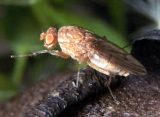
Heleomyzidae
Encyclopedia
Heleomyzidae is a small family of true flies in the insect
order
Diptera
. There are over 650 described species
of Heleomyzidae in about 80 genera
and 22 tribes distributed throughout the world; the greatest number occur in the Holarctic
Region. Approximately 100 species of Heleomyzidae are found in North America
. Larva
e feed on decaying plant and animal matter, mushrooms and various fungi. All of the subfamilies have been commonly recognized as families in the past, but are now included within the Heleomyzidae (McAlpine,D.K.,1985).
Heleomyzidae are small to medium sized flies which vary in colour from yellow to reddish yellow or reddish brown to black. The wings
often have small but distinctly longer, well-spaced spines mixed with the shorter spines along the leading edge and the crossveins are often clouded.
Adults of Borboroides and Heleomicra are attracted to carcasses and faeces. The larvae of the Holarctic Suillinae and Tapeigaster occur principally in fungi. Larvae of Cairnsimyia live in borer tunnels in trees.
Insect
Insects are a class of living creatures within the arthropods that have a chitinous exoskeleton, a three-part body , three pairs of jointed legs, compound eyes, and two antennae...
order
Order (biology)
In scientific classification used in biology, the order is# a taxonomic rank used in the classification of organisms. Other well-known ranks are life, domain, kingdom, phylum, class, family, genus, and species, with order fitting in between class and family...
Diptera
Diptera
Diptera , or true flies, is the order of insects possessing only a single pair of wings on the mesothorax; the metathorax bears a pair of drumstick like structures called the halteres, the remnants of the hind wings. It is a large order, containing an estimated 240,000 species, although under half...
. There are over 650 described species
Species
In biology, a species is one of the basic units of biological classification and a taxonomic rank. A species is often defined as a group of organisms capable of interbreeding and producing fertile offspring. While in many cases this definition is adequate, more precise or differing measures are...
of Heleomyzidae in about 80 genera
Genus
In biology, a genus is a low-level taxonomic rank used in the biological classification of living and fossil organisms, which is an example of definition by genus and differentia...
and 22 tribes distributed throughout the world; the greatest number occur in the Holarctic
Holarctic
The Holarctic ecozone refers to the habitats found throughout the northern continents of the world as a whole. This region is divided into the Palearctic, consisting of Northern Africa and all of Eurasia, with the exception of Southeast Asia and the Indian subcontinent, and the Nearctic,...
Region. Approximately 100 species of Heleomyzidae are found in North America
North America
North America is a continent wholly within the Northern Hemisphere and almost wholly within the Western Hemisphere. It is also considered a northern subcontinent of the Americas...
. Larva
Larva
A larva is a distinct juvenile form many animals undergo before metamorphosis into adults. Animals with indirect development such as insects, amphibians, or cnidarians typically have a larval phase of their life cycle...
e feed on decaying plant and animal matter, mushrooms and various fungi. All of the subfamilies have been commonly recognized as families in the past, but are now included within the Heleomyzidae (McAlpine,D.K.,1985).
Heleomyzidae are small to medium sized flies which vary in colour from yellow to reddish yellow or reddish brown to black. The wings
Insect wing
Insects are the only group of invertebrates known to have evolved flight. Insects possess some remarkable flight characteristics and abilities, still far superior to attempts by humans to replicate their capabilities. Even our understanding of the aerodynamics of flexible, flapping wings and how...
often have small but distinctly longer, well-spaced spines mixed with the shorter spines along the leading edge and the crossveins are often clouded.
Adults of Borboroides and Heleomicra are attracted to carcasses and faeces. The larvae of the Holarctic Suillinae and Tapeigaster occur principally in fungi. Larvae of Cairnsimyia live in borer tunnels in trees.
External links
- Heleomyzid fly Suillia sp. diagnostic photographs
- Family description and figures
- The European subfamilies, tribes, genera and species- Fauna Europaea
Palaearctic
- Czerny, L.Leander CzernyLeander Czerny was an Austrian entomologist mainly interested in Diptera....
, 1924. Monographie der Helomyziden. Abhandlung der Zoologischen-Botanischen Gesellschaft in Wien, 15(1): 1–166. Keys genera and species. - Czerny, L., 1937. Ergänzungen zu meiner Monographie der Helomyziden. X. Konowia, 16(2): 137–142.
- Gorodkov, K.B., 1984. Family Heleomyzidae (Helomyzidae), 15–45.In: Soós Á. and L. Papp, (eds.), Catalogue of Palaearctic Diptera,vol.10, Budapest.
- Papp, T.,1978. Some cavernicolous Diptera of the Geneva Museum. Revue Suisse de Zoologie 85: 99-106.
- Papp, T., 1998. Heleomyzidae. Chapter 3.41, 439–455. In: Papp L. and B. Darvas, (eds.), Contribution to a manual of Palaearctic Diptera. Vol. 3. 1998. Science Herald, Budapest, 880 pp.
UK
- Collin, J.E.James Edward CollinJames Edward Collin was an English entomologist who specialised in Diptera.He was the author of Empididae. British Flies, Volume 6. University Press, Cambridge...
1943b. The British species of Helomyzidae (Diptera). Entomologist's monthly Magazine 79: 234-251.
Nearctic
- Gill, G.D., 1962. The Heleomyzid flies of America north of Mexico(Diptera: Heleomyzidae). Proceedings of the U.S. National Museum, 113(3465): 495-603. Keys genera and species.
- Gill, G.D and B.V. Peterson, 1987.1989. Heleomyzidae, 973-980. In:McAlpine J. F., (ed.), Manual of Nearctic Diptera Vol. 2, Research Branch Agric. Canada, Monograph no. 28, IV + 675–1332. Keys genera and species.
Australasia
- McAlpine, D.K., 1985. The Australian genera of Heleomyzidae (Diptera: Schizophora) and a reclassification of the family into tribes. Records of the Australian Museum, 36: 203–251.

